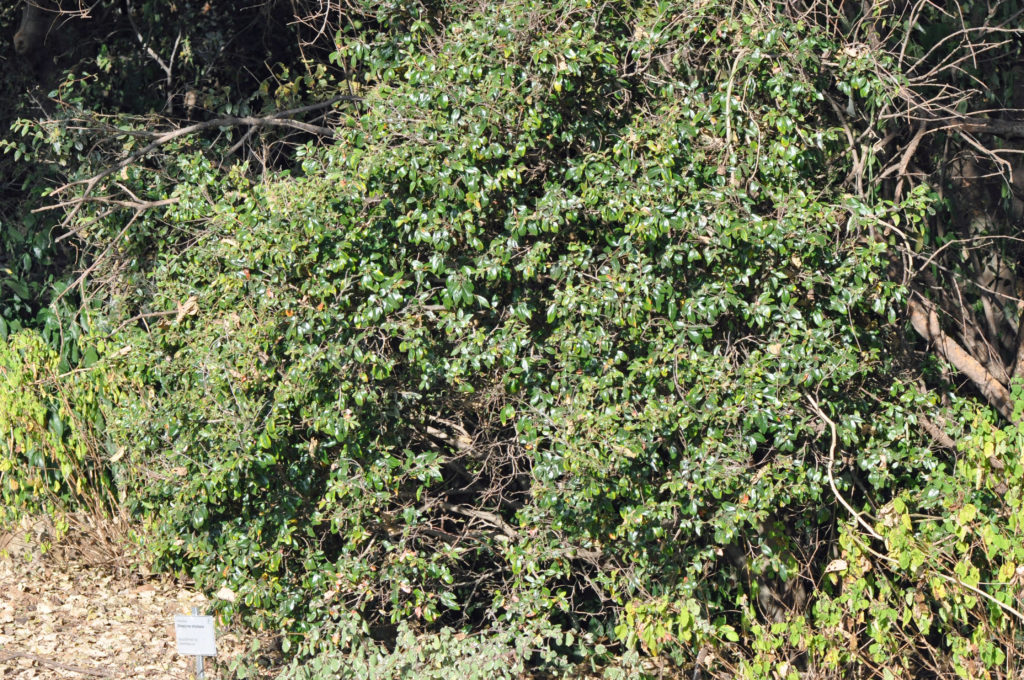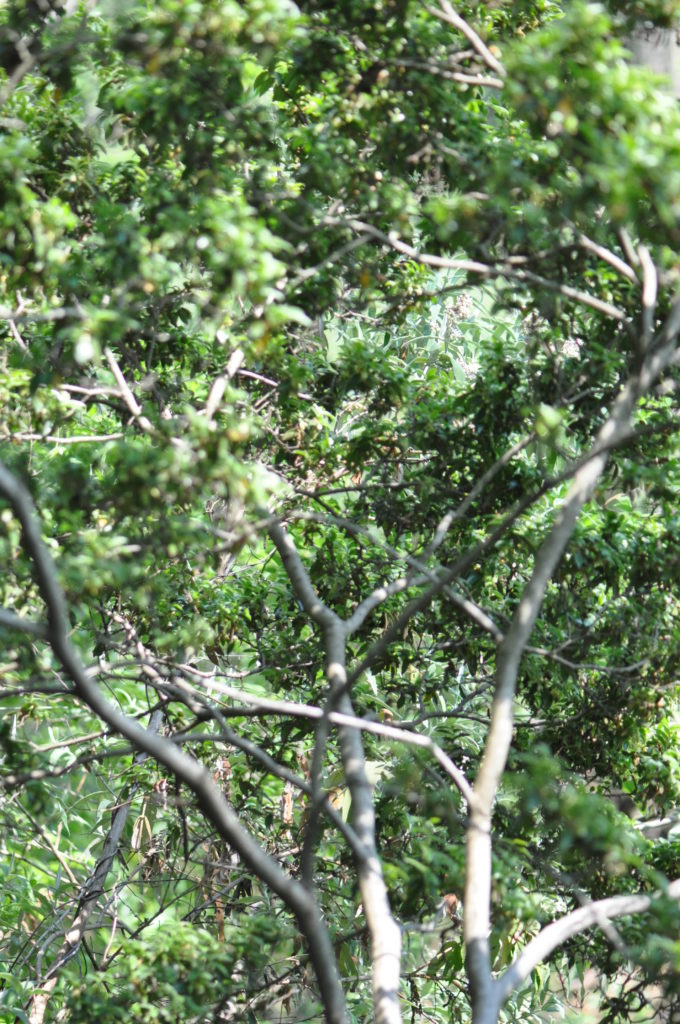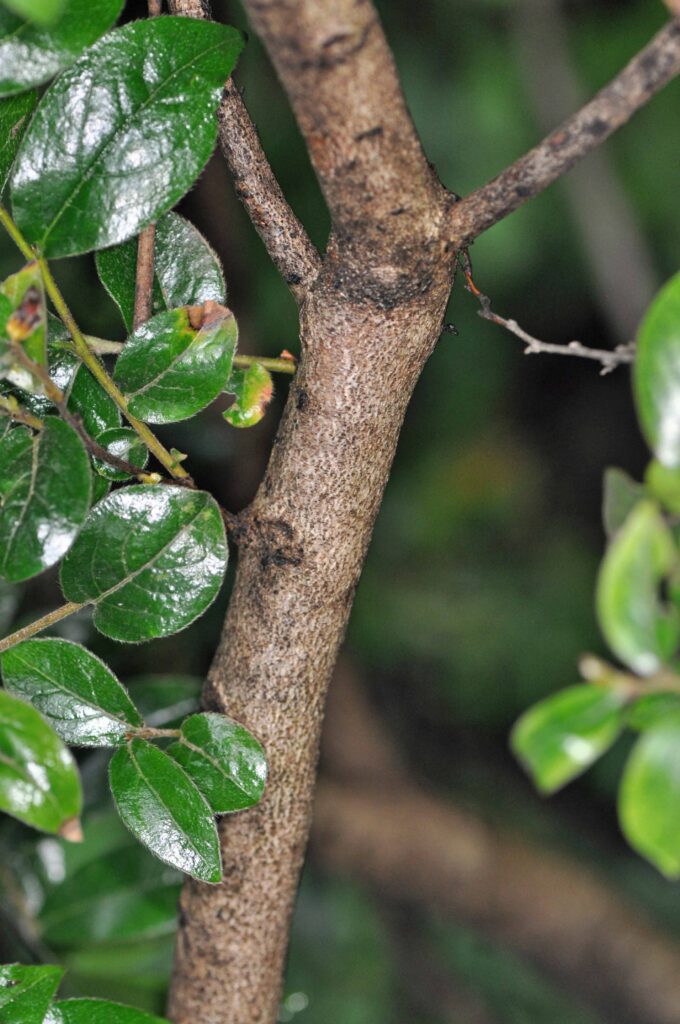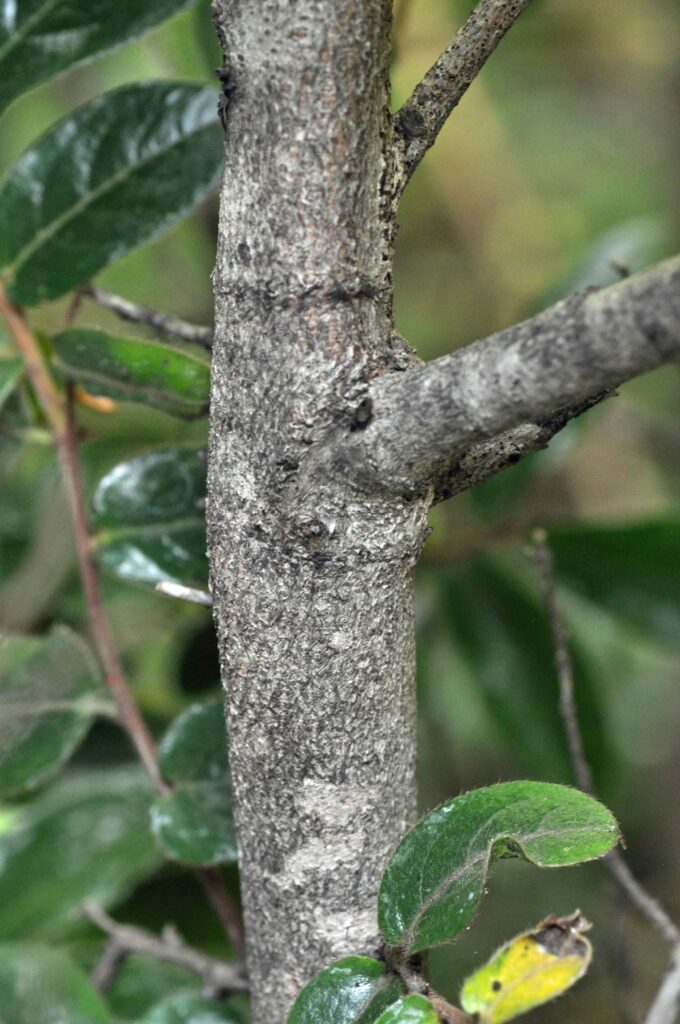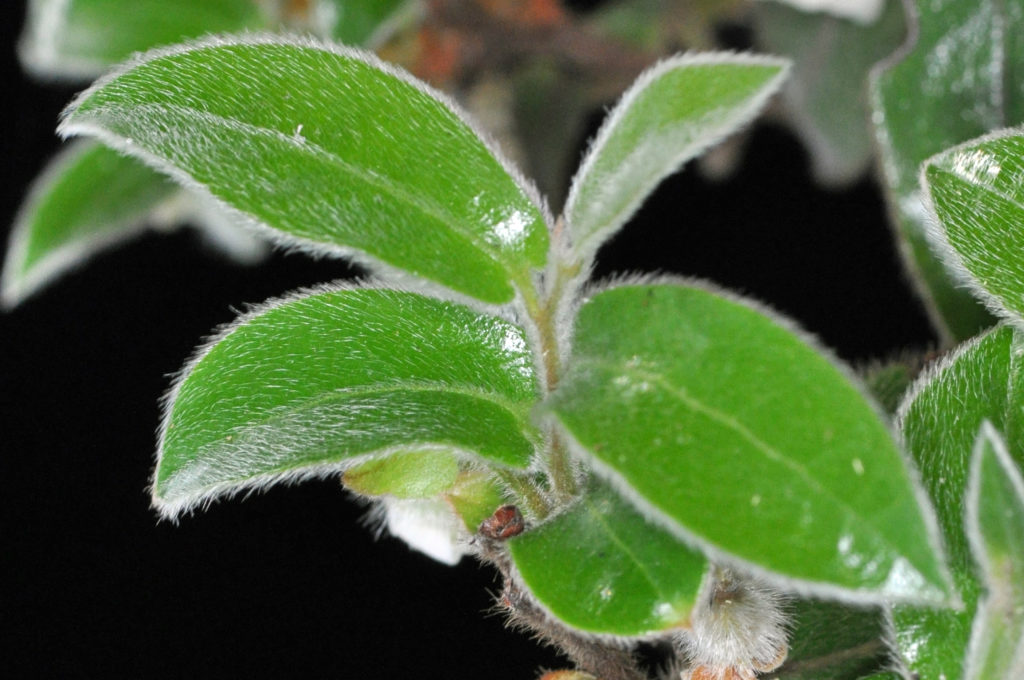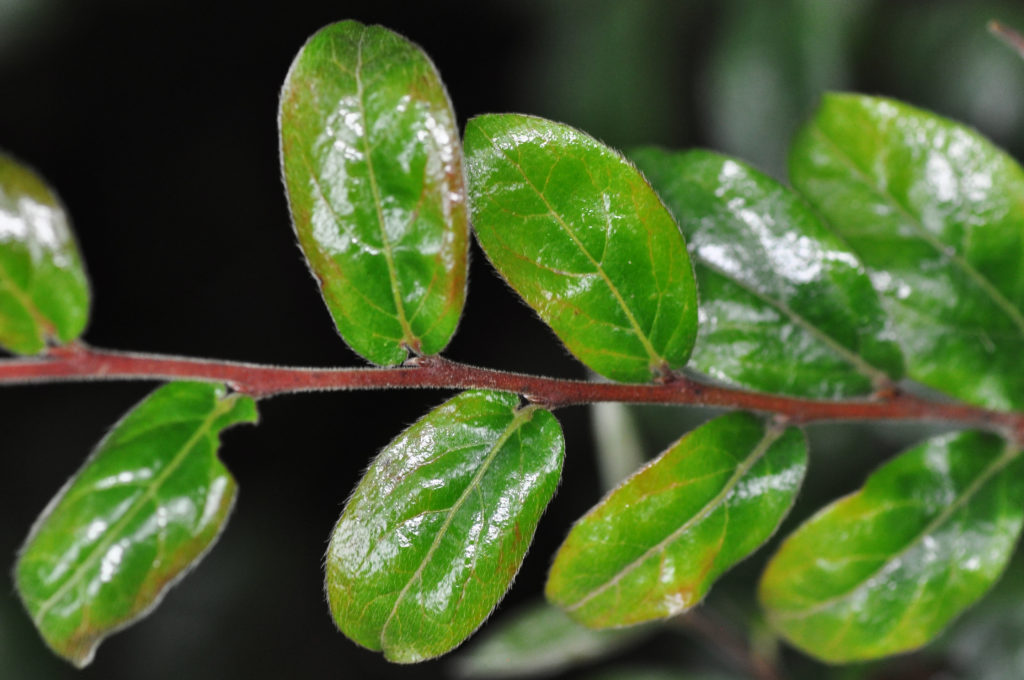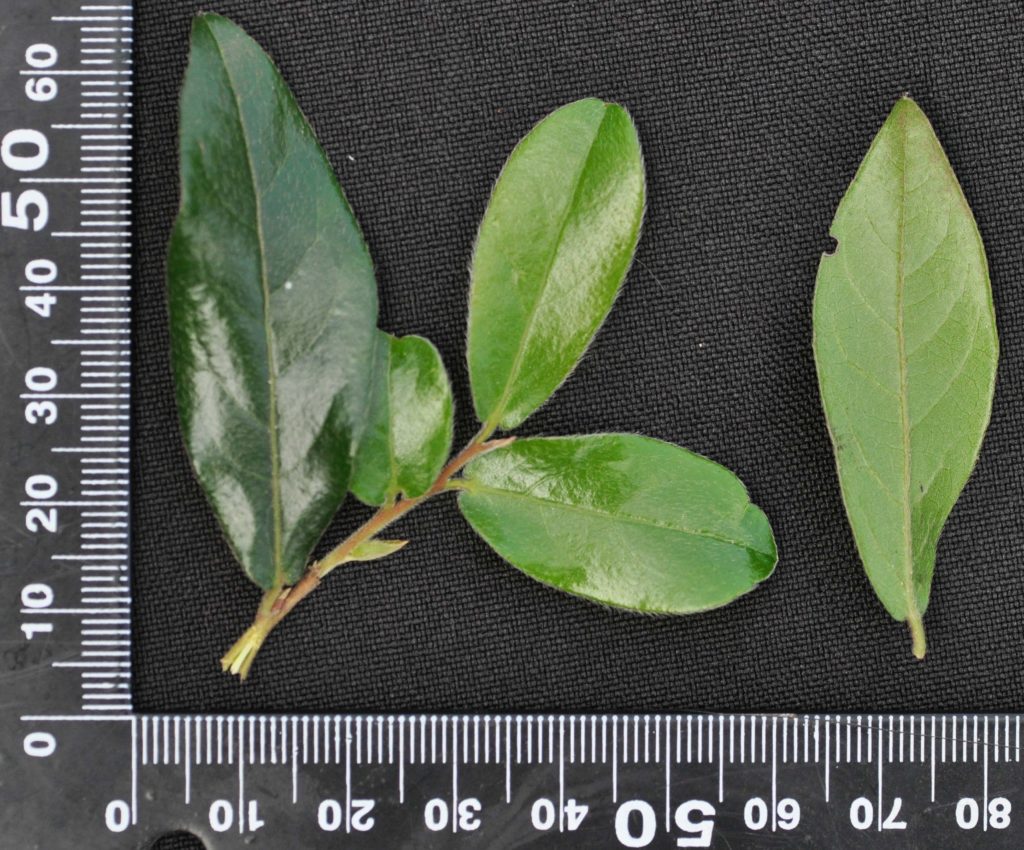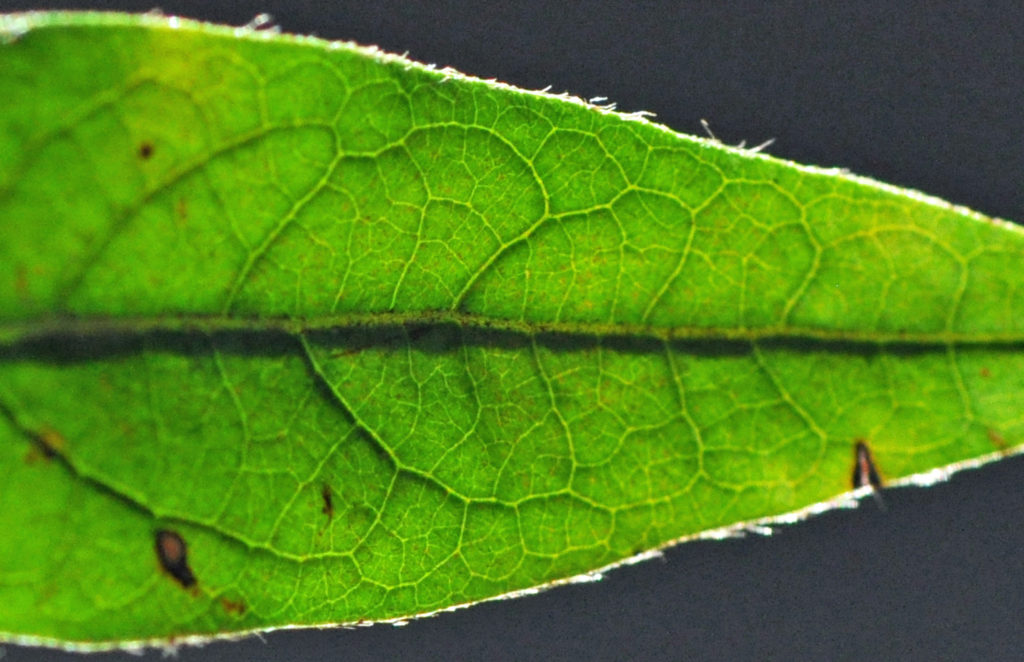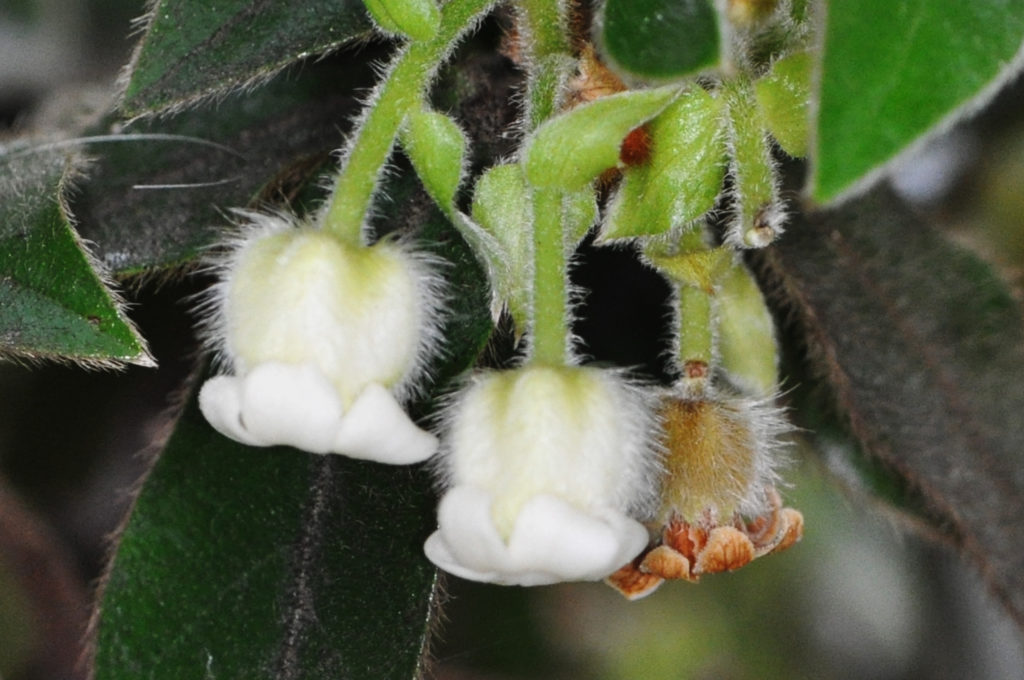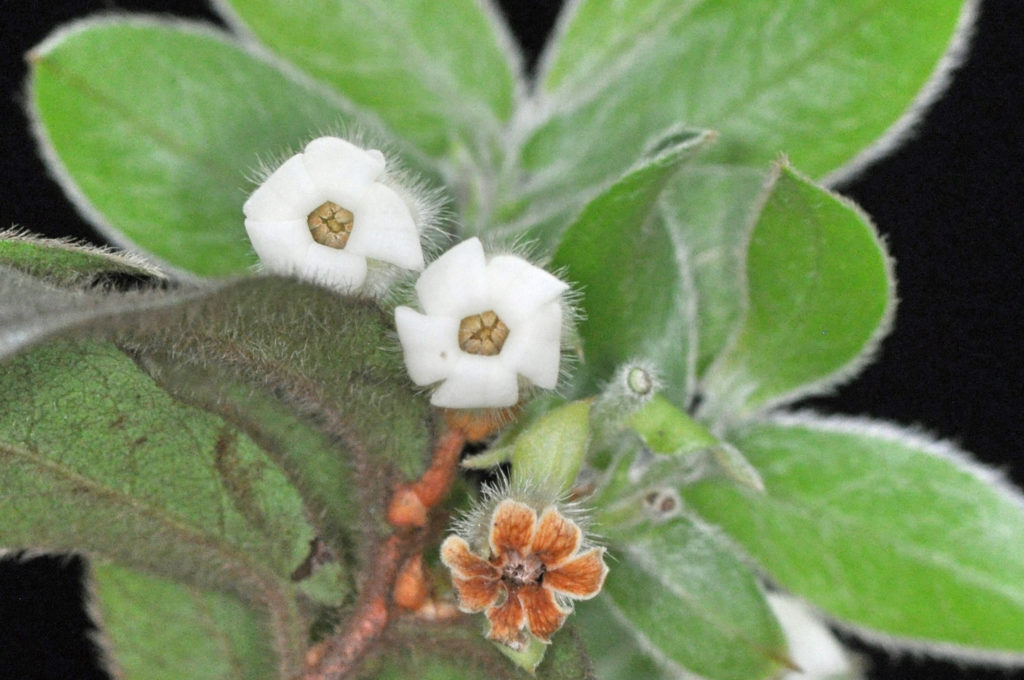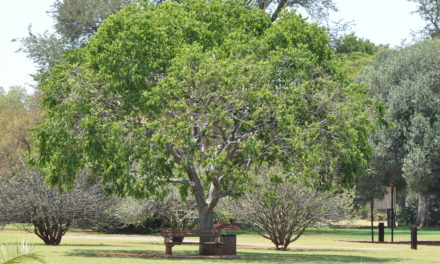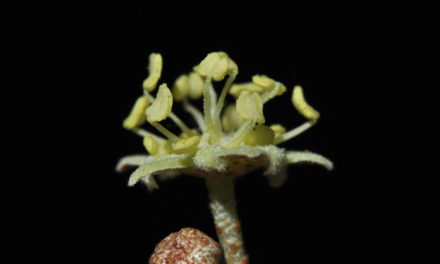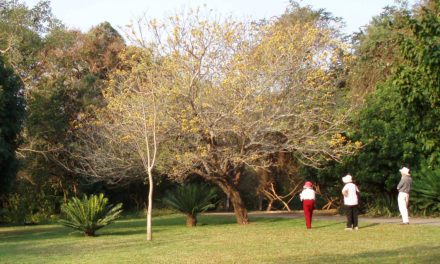General Info – summary
The dioecious spineless and evergreen Tree seldom reaches 14m high and has a trunk up to 30cm wide. The attractive glossy and visibly hairy Leaves are simple with an entire margin. Small, regular, white and pendulous Flowers are 4 or 5-merous. In female flowers, staminodes and a single pistil are present, as is a hairy pedicel is. Fruit is a berry with an accrescent calyx – producing 2 to 4 seeds.
Description
Diospyros whyteana
Previous Names: Royena acocksii, Royena lucida, Royena whyteana, Royena goetzei, Royena nyassae, Royena wilmsii.
SA Tree No. 611.
Common names: (Afr) Bostolbos, Kraaibessie, Swartbas, Tolletjie, Tolletjies. (Eng) African Bladder Nut, Black bark, Bladdernut, Bladder-nut, Cape Blackwood, Hottentots Cherry, Orange River Diospyros, Wild coffee. (isiXhosa) Insanzimane, Intsanzimane, Umkhaza, Umbongisa, Umgungunga, Umtenatane, Umtenatene. (isiZulu) Umanzimane, Umkhaze, Umnqandane, Umtimatane. (Northern Sotho) Mohlatsane. (siSwati) Santinyana. (Tshivenda) Munyavhili, Mwanda.
Family: Ebenaceae (persimmon and ebony family). The family has some plants known for their useful wood and others for fruit. Trees are usually located in tropical and warmer temperate regions. There are more than 750 species, in 4 genera, worldwide and the 37 species in South Africa occur in 2 genera (Euclea and Diospyros). The bark and heartwood are black. The simple, coriaceous and entire Leaves lack stipules and are usually alternate or may be opposite, but both may occur on the same plant. The usually unisexual and regular Flowers have a persistent calyx that is often divided near to the base. The corolla usually has a short tube, with Petals fused at the base and extending into overlapping lobes. The basifixed anthers are longer than the filaments. The superior ovary has up to 2 ovules in each locule. The styles may have 2-5 branches. Fruit is a berry with an accrescent calyx, which may dehisce slowly. Young fruit contains tannins and is usually avoided by animals until ripe.
Worldwide there are in excess of 700 species in the genus Diospyros. These species are tropical and subtropical and usually dioecious (unisexual floral structures with male and female parts are on separate plants).
In southern Africa, there are about 20 species in the genus. The valued timber trees are called Ebony trees. These produce dense, hard and dark timber. Trees valued for their fruit are known as persimmon trees and none of these are indigenous.
Name derivation: Diospyros (Dios – divine pyros – pear (referring to the flavour of some fruits). whyteana: named after Alexander Whyte (1834-1908) a Scottish explorer who collected plants from Malawi, Kenya, Liberia and Uganda for Kew during 1883-1904.
Worldwide there are in excess of 700 species in the genus Diospyros. The valued timber trees are called Ebony trees. These produce dense, hard and dark timber. Trees valued for their fruit are known as persimmon trees and none are indigenous. Diospyros plants are tropical (most) or subtropical and usually dioecious (unisexual floral structures with male and female parts are on separate plants). In southern Africa, there are about 20 species in the genus.
Conservation: National Status: L C. (Least Concern). Assessment Date: 2005 W. Foden and L. Potter.
Tree
This Tree may reach 14m high but usually much less and may be a shrub. In a tree, the single stemmed Trunk has a diameter of up to 30cm and has densely spreading branches that occur low down. The Bark (photos 447 & 524) is grey to almost black and smooth. In older trees, the bark may become rough. The greenish or pinkish, long and flexible Young branches are slightly angled between leaves and are densely covered with long, fine and rust coloured hairs. These young flexible branches (photo 445 under Leaves) are intertwined. No milky sap or spines are present.
- 345. 2015/05/19 Walter Sisulu NBG. Photo: David Becking.
- 652. 2015/09/22 Walter Sisulu NBG. Photo: David Becking.
- 447. 2014/12/09 Walter Sisulu NBG. Photo: David Becking.
- 524. 2015/10/20 Walter Sisulu NBG. Photo: David Becking.
Leaves
Leaves are an outstanding feature of this plant. This evergreen plant has alternate Leaves (photo 445) that are narrowly elliptic, ovate to obovate (like an upside down egg – with the narrower end at the base) or broadly lanceolate. Silky threads become visible in a recently broken young leaf. Young hairy leaves (photo 214) may be coppery-green. The slightly leathery leaves are up to 4,5 x 3cm and are simple (has a single blade, which may have incisions that are not deep enough to divide the blade into leaflets). Leaves from the winter rainfall areas of the Western Cape are usually larger. The upper leaf surface is distinctly glossy (photo 445), dark, yellow-green or pinkish and has more attractive white hairs when young (photo 214). These hairs do not hide the gloss. The lower leaf surface is much paler, duller green with some longish hairs, which occur both on the veins and between them. About 6 pairs of Lateral veins are present but are not very prominent and sunken above (photo 446). The raised Midrib is visible on both sides. Lateral veins are slightly clearer below. Veins are more visible when viewed against a strong light – aided with a hand lens (photo 62). Here marginal hairs are visible, as are the lateral veins joining with others prior to reaching the margin. The Apex is narrowly to broadly tapering. The Base tapers and may be almost rounded or Cordate (heart-shaped – photo 445). The slightly wavy Margin is entire (with a continuous margin, not in any way indented). The hairy and relatively short Petiole (leaf stalk) is up to 0,5cm long. An occasional bright red or orange leaf occurs.
- 214. 2015/09/15 Walter Sisulu NBG. Photo: David Becking.
- 445. 2014/12/09 Walter Sisulu NBG. Photo: David Becking.
- 446. 2020/01/19 Walter Sisulu NBG. Photo: David Becking.
- 62. 2017/03/21 Pretoria NBG. Photo: David Becking. Leaf + sun.
Flowers
This tree/shrub should be planted in gardens and visitors given a hand lens to view the very impressive small white, cream to pale yellow, fragrant and pendulous Flowers (photo 218). Trees are dioecious (unisexual floral structures with male and female parts on separate plants). Flowers are up to 1cm long and actinomorphic (Regular, symmetrical. Flowers are vertically divisible into similar halves by more than 1 plane passing through the axis). They have 2 nearly opposite leafy bracts which are about 2cm long and occur about half-way up the 2cm long the hairy Pedicle (flower stalk – photo 218). Flowers may occur singly or in short axillary sprays. The Calyx is hairy and has 4 or 5 toothed Sepals. The Corolla is urceolate (with a swollen middle and narrowing top – urn shaped). It has 5 Petals which are united at the base. These white petals end with relatively short, recurved lobes (photo 218). Male flowers are solitary and axillary with 10 stamens. Here the Filaments are shorter than the basifixed (attached by its base) Anthers. Female flowers are similar to male flowers but have 6-10 staminodes (sterile stamens). The single Pistil (a unit of the Gynoecium, the female element of the flower, composed of the Ovary, Style and Stigma) contains a superior Ovary situated on a somewhat fleshy, hairless Disc (a more or less fleshy or elevated development of the receptacle). (Aug-Nov).
- 218. 2015/09/15 Walter Sisulu NBG. Photo: David Becking.
- 213. 2015/09/15 Walter Sisulu NBG. Photo: David Becking.
Fruit
The Fruit is up to 2cm long. It is an ovoid to an almost spherical fleshy Berry (pulpy, indehiscent fruit like a grape or tomato), which is up to 2cm in diameter. The ripe fruit turns a distinctive bright red to scarlet and finally becomes reddish brown or blackish. The persistent Calyx has 5 large, inflated lobes that that are accrescent (continue to grow after flowering). They envelope the up to 2cm long fruit in a papery covering and remain on the tree for months after the fruit has fallen. These calyx lobes are loose but completely cover the up to 3cm long fruit – making it look like a swollen bladder (hence the common name). The persistent calyx remains on the tree for months after the fruit has fallen. It is now reddish brown and papery (photos 218 & 213 above). Up to 4 oblong Seeds are produced. They are about 8mm long, smooth and pale brown. A single, thin straight line encircles each seed. The Pulp around the seeds has a bittersweet taste. The fruit (Jun – Oct) is almost identical to that in Diospyros scabrida.
Distribution & Ecology
This frost resistant tree grows on mountains, open forests, forest margins, shady kloofs, stream banks, scrubs and rocky outcrops. It is slow growing and becomes taller and thinner if not in full sun and is found from sea level to 2 200m. It occurs in most of the mountain forests and mist belts in South Africa. This plant occurs on Table Mountain in the Western Cape, the Eastern Cape, the eastern Free State, Gauteng (common), KwaZulu-Natal, Limpopo, Mpumalanga (common), and North West. In addition, this the plant grows in fringes around Lesotho, central and slightly northern Mozambique, Swaziland, Zimbabwe, Tanzania, Malawi and northwards to Ethiopia. Game brows the Leaves and birds like the African Green pigeons, louries (touracos), bulbuls and barbets consume the Fruit. These plants may be grazed to such an extent that they remain dwarf shrubs.
Ethnobotany
This plant, with its dark glossy evergreen foliage, makes a good garden tree. It thrives in both shade and full sun and can make an excellent hedge. Both male and female trees are required for fruit production. This is achievable by using cutting from male and female plants. Parts of the Tree are used in local medicine. It also makes a good bonsai specimen. The reasonably dense Wood is yellowish-white with purplish grey stripes, evenly grained, fairly dense and tough. Yokes, wagons and furniture were made from it. Today it is used to make axe, hoe and pick handles. Seeds reputed to make a good substitute for coffee. Prior to planting, the seeds should be scarified (to slit or scratch the outer coat of seeds in order to speed up germination). This evergreen, ornamental plant is drought resistant. Local medicine makes use of this plant. This is a popular garden tree and bonsai plant.
References
Boon, R. 2010. Pooley’s Trees of eastern South Africa. Flora and Fauna Publications Trust, Durban.
Burrows, J.E., Burrows, S.M., Lotter, M.C. & Schmidt, E. 2018. Trees and Shrubs Mozambique. Publishing Print Matters (Pty) Ltd. Noordhoek, Cape Town.
Coates Palgrave, M. 2002. Keith Coates Palgrave Trees of Southern Africa. edn 3. Struik, Cape Town.
Foden, W. & Potter, L. 2005. Diospyros whyteana (Hiern) F.White. National Assessment: Red List of South African Plants version 2020.1. Accessed on 2022/01/08.
Ginn, P.J. McIlleron, W.G. Milstein, S. 1989. The Complete Book of Southern African Birds. Struik Publishers (PTY) LTD. Third impression 1991.
Lawrence, G. H. M, 1951. Taxonomy of Vascular Plants. The Macmillan Company, New York. Tenth Printing 1965.
Palmer, E. & Pitman, N. 1972. Trees of southern Africa. Balkema, Amsterdam, Cape Town.
Schmidt, S. Lotter, M. & McCleland, W. 2002. Trees and Shrubs of Mpumalanga and the Kruger National Park.
van Wyk, B. & van Wyk, P. 1997 Field guide to Trees of Southern Africa. Struik, Cape Town.
https://en.wikipedia.org/wiki/Diospyros_whyteana
http://witkoppenwildflower.co.za/diospyros-whyteana/
http://www.zimbabweflora.co.zw/speciesdata/species.php?species_id=144080
http://www.smgrowers.com/products/plants/plantdisplay.asp?plant_id=3998
http://www.prota4u.org/protav8.asp?p=Diospyros+whyteana

